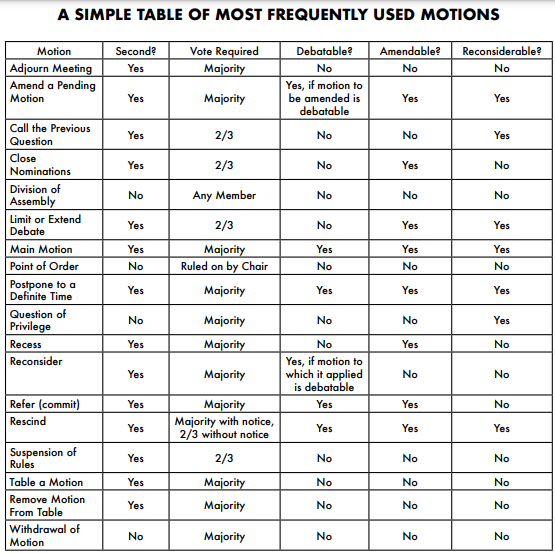Making a Motion
Only current PTA members are legally qualified to make motions, discuss, and vote. A quorum must be present.
- Obtain the floor... Member rises and addresses the chair or raises hand: “Madam President.”
- Assign the floor... Chair recognizes the member: “The chair recognizes —”
- Make the motion... Member makes a motion: “I move that —”
- The motion is seconded... Another member seconds the motion: “Second (or) I second the motion.”
- Debate and comments... Chair states the motion and opens debate: “It is moved and seconded that — Is there any discussion?”
- Debate or discussion... Chair recognizes members wishing to speak. Members wait to be called on by chair and speak.
- Vote... After debate concludes, chair puts the question to a vote: “The question is on the motion — (chair should read the motion again). Those in favor of the motion say aye. Those opposed say no.”
- Result. Chair then announces the result of the vote and what action will be taken: “The Ayes have it, and the motion is adopted. We will — (states action to be taken).” - OR - “The Nos have it, and the motion fails.”
The chair then continues with the next item of business in order, using the above steps as often as necessary
Voting Types
- General Consent vote: “If there is no objection, we will — . Are there any objections? Seeing no objection, we will—” - OR - “Seeing there is objection we will — .
- Voice vote: “As many as are in favor say ‘aye.’ Those opposed, say ‘no.’” “The ‘ayes/nos’ have it, and the motion is adopted/defeated.
- Rising vote (not counted): “Those in favor will rise. Thank you, be seated. Those opposed will rise. Thank you, be seated. “The ‘ayes/nos’ have it, and the motion is adopted/defeated.”
- For a voice or rising vote, if a majority is not evident, a count should be taken.
- If a voice vote majority is not evident, the chair then declares there will be a rising vote.
- Counters can/should be designated in advance to be prepared to go through the audience and physically count the yea and then the nay votes, reporting their totals to the chair.
Amending a Motion
An amendment is a way to change a motion already on the floor before a vote is taken on the motion. It may be amended by:
- By striking out: Example: “I move to amend the motion by striking out the word ‘Denver.’”
- By inserting: Example: “I move to amend the motion by inserting the word ‘Las Vegas’ after the word ‘Portland.’”
- By striking out and inserting: Example: “I move to amend the motion by striking out the phrase ‘$35’ and inserting the phrase ‘$50.’”
- Substituting one paragraph or resolution for another.
Examples:
Main motion: “I move we have a parenting program at the park.”
Inserting: “I move to amend the motion by adding ‘in October’ after ‘program’ [effect of amendment if adopted: “I move we have a parenting program in October at the park.”]
Striking: “I move to amend the motion by striking “at the park” [effect of amendment if adopted: “I move we have a parenting program in October.”]
Striking and inserting: “I move to amend the motion by striking ‘October’ and inserting ‘November on the school grounds’ [effect of amendment if adopted: “I move that we have a parenting program in November on the school grounds.”]
Substituting: “I move to substitute the following for the motion on the floor: ‘that we have an ice cream social’.” [Effect of amendment if adopted: “I move that we have an ice cream social.”]
MOTION LANGUAGE
Almost every motion begins with the simple words “I move….” To accomplish other types of motions follow the PTA motion chart (below) adapted from Roberts Rules of Order.

